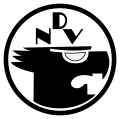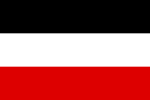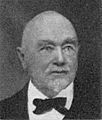German National People's Party facts for kids
Quick facts for kids
German National People's Party
Deutschnationale Volkspartei
|
|
|---|---|
 |
|
| Other name | German National Front (May–June 1933) |
| Abbreviation | DNVP |
| Chairman |
List
Oskar Hergt (1918–1924)
Johann Friedrich Winckler (1924–1926) Kuno Graf von Westarp (1926–1928) Alfred Hugenberg (1928–1933) |
| Founded | 24 November 1918 |
| Dissolved | 27 June 1933 |
| Merger of | • German Fatherland Party • German Social Party • German Völkisch Party • German Conservative Party • Free Conservative Party • Christian Social Party • National Liberal Party (far-right faction) |
| Succeeded by | Pre-war: Single-party system of the NSDAP Post-war: Deutsche Rechtspartei (DKP-DRP) |
| Newspaper | Supported by the Hugenberg Group |
| Youth wing | Bismarckjugend |
| Paramilitary wings | • Der Stahlhelm, Bund der Frontsoldaten • Kampfstaffeln |
| Policy institute | Pan-German League |
| Women’s wing | Queen Louise League (unofficial) |
| Trade unions | • Deutschnational Arbeiterbund • Deutschnationaler Angestelltenbund |
| Membership | 950,000 (c. 1923) |
| Ideology | Pan-Germanism German nationalism National conservatism Social conservatism Military rearmament Right-wing populism Volksgemeinschaft Authoritarian conservatism Reactionary monarchism Anti-Treaty of Versailles Anti-communism Antisemitism |
| Political position | Right-wing to far-right |
| Political alliance | • Opposition to the Young Plan (1929) • Harzburg Front (1931) |
| Electoral alliance | Black-White-Red Struggle Front (1933) |
| Colours | Black, white and red (official, German Imperial colours) Light blue (customary) |
| Seats in the Reichstag (1924) |
103 / 493
|
| Party flag | |
 |
|
|
^ a: The German National People's Party (DNVP) was divided between reactionary conservative monarchists and more radical völkisch and anti-semitic elements. |
|
The German National People's Party (in German: Deutschnationale Volkspartei), often called the DNVP, was a political party in Germany. It was active during the time of the Weimar Republic and the early years of Nazi Germany. The party was started in 1918, right after World War I.
The DNVP was known for its very traditional and nationalist ideas. They wanted Germany to be strong and proud again after the war. They also believed in a king or queen ruling the country, rather than a republic. The party had some members who held strong negative views against Jewish people. In June 1933, the DNVP joined with the NSDAP.
Contents
Leaders of the DNVP
The DNVP had several important leaders during its time. These leaders helped guide the party and its goals.
- Oskar Hergt (1918 to 1924): He was the first leader of the party.
- Kuno Graf von Westarp (1924 to 1928): He took over leadership after Hergt.
- Alfred Hugenberg (1928 to 1933): He was the last leader of the DNVP before it merged with the Nazi Party.
What the DNVP Believed In
The German National People's Party had several key beliefs that shaped its actions.
Strong German Identity
- They strongly believed in German nationalism. This means they thought Germany and its people were very special and important.
- They supported Pan-Germanism, which was the idea of uniting all German-speaking people under one rule.
Traditional Values
- The party was very conservative. They wanted to keep old traditions and ways of life.
- They believed in monarchy, meaning they wanted to bring back a king or emperor to rule Germany. This was a big difference from the Weimar Republic, which was a democracy.
Against the Treaty of Versailles
- The DNVP was strongly against the Treaty of Versailles. This treaty was signed after World War I and placed many harsh rules on Germany.
- They felt the treaty was unfair and wanted to change it, especially the parts that limited Germany's military. They pushed for German rearmament, which meant rebuilding Germany's armed forces.
Anti-Communism and Other Views
- The party was very much against communism. They saw communists as a threat to Germany's traditional way of life.
- Some members of the party held views that were against Jewish people. This was a harmful belief that became more common in Germany at that time.
The End of the DNVP
The DNVP was a powerful party for a while, but its influence began to change. In 1933, Germany's political situation became very unstable. The NSDAP was gaining a lot of power. The DNVP eventually merged with the NSDAP in June 1933. This marked the end of the German National People's Party as a separate political group.
Images for kids
-
A DNVP poster from 1920 showing a Teutonic knight being attacked by Poles and socialists as the caption reads "Save the East"
-
In 1924, the DNVP made a major push to have Admiral Alfred von Tirpitz as Chancellor, sparking widespread international condemnation
-
Kuno von Westarp (second from the left) together with Hohenzollern princes at the DNVP convention, 1924
-
The DNVP campaigns for Paul von Hindenburg in the 1925 election
-
Franz Seldte (right) with Alfred Hugenberg and Major Franz von Stephani at a rally against the Young Plan, Berlin Sportpalast, 1929
-
Elard von Oldenburg-Januschau, whose advice to President Hindenburg to appoint Adolf Hitler Chancellor in January 1933 played an important role in bringing Hitler to power
See also
 In Spanish: Partido Nacional del Pueblo Alemán para niños
In Spanish: Partido Nacional del Pueblo Alemán para niños
















